22.12.2018
Die Erkundung des Marsinneren beginnt
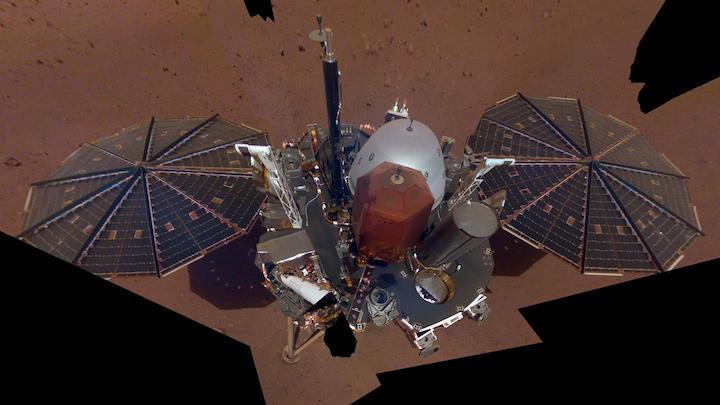
- Absetzstelle für DLR-Marsmaulwurf HP³ ist ausgewählt.
- Zum Auftakt wurde das Seismometer SEIS auf der Marsoberfläche ausgesetzt.
- DLR-Wissenschaftler und Ingenieure leisten umfängliche Beiträge zur Analyse der Landestelle und zur Absetzstellenauswahl.
- Mitglieder des DLR-Teams verbringen Weihnachten beim JPL in Kalifornien.
- Schwerpunkte: Raumfahrt, Exploration, Robotik
Es war eine zentimetergenaue Detailarbeit. In den vergangenen Wochen haben DLR-Forscher jeden Stein auf den Bildern der InSight-Landestelle vermessen und mit dem Radiometer des HP³-Experiments den Staub an der Marsoberfläche analysiert, um gemeinsam mit den amerikanischen und französischen Kollegen die idealen Absetzstellen für die Instrumente der InSight-Mission zu identifizieren. Schließlich bildeten Wissenschaftler des Jet Propulsion Laboratory (JPL) in Kalifornien auf Grundlage der Untersuchungen InSights angrenzende Umgebung exakt im Labor nach und testeten die Absetzmanöver mit einem Nachbau der NASA-Sonde. Mit der nun erfolgten Platzierung des Seismometers vor dem Lander beginnt die Erkundung des Marsinneren. Der Marsmaulwurf des Deutschen Zentrums für Luft- und Raumfahrt (DLR) wird Ende Januar 2019 einen Meter östlich des Seismometers positioniert werden. Ein vierköpfiges Team des Kölner DLR-Nutzerzentrums für Weltraumexperimente verbleibt für die Kommandierung und Überwachung des HP³-Experiments auch über Weihnachten und Silvester in Kalifornien.
"Wir sind sehr glücklich über InSights sandig flache Landestelle, sagt der wissenschaftliche Leiter des HP³-Experiments Prof. Tilman Spohn vom DLR-Institut für Planetenforschung in Berlin. "Nach intensiver Analyse der geologischen Gegebenheiten, in die sich viele DLR-Kollegen des HP³-Teams intensiv eingebracht haben, können wir aufatmen. Ohne größere Steine im Arbeitsbereich des robotischen Arms oder Fragmente, die auf größere Steine direkt unter der Oberfläche schließen lassen, ist uns die Auswahl der Absetzstelle für HP³ schließlich deutlich leichter als erwartet gefallen.“ Die jetzt festgelegte Absetzstelle befindet sich in rund 1,60 Meter Entfernung mit möglichst großem Abstand zur Muttersonde. Das verhindert Schattenwürfe, die sonst die Temperaturmessungen mit HP³ stören würden.
Bei Auswahl und Tests der Absetzstellen mussten die Forscher auch sicherstellen, dass die empfindlichen Kabel, die die Instrumente am Boden mit der Muttersonde verbinden, nicht an scharfen Felskanten verfangen oder reiben. Auch hierbei war die flache, weitestgehend steinfreie Umgebung hilfreich. "Vermutlich ist InSight am 26. November 2018 in einem mit Sand aufgefüllten Meteoritenkrater gelandet“, erklärt HP³-Wissenschaftler Dr. Matthias Grott die geologischen Gegebenheiten. „Das sollte es dem Marsmaulwurf erleichtern, wie geplant in bis zu fünf Meter Tiefe für Temperatur und Wärmeflussmessungen vorzudringen.“ Allerdings bleibt es Ende Januar spannend, welche Verhältnisse der Maulwurf unter der Mars-Oberfläche vorfindet. „Unter der Landesonde haben wir größere Steine gesehen, die natürlich auch tiefer auftreten könnten“, so der DLR-Planetenforscher über die bleibende Anspannung.
Weihnachten in Kalifornien und Aufwärmen bei knapp -90 Grad Celsius in der Marsnacht
Aktuell befindet sich HP³ noch auf der InSight-Landeplattform. Dort haben die Wissenschaftler bereits das Radiometer des Experiments in Betrieb genommen, das unter anderem die Oberflächentemperatur auf dem Mars registriert. Diese soll später mit den Temperaturmessungen des Maulwurfs im Untergrund verglichen werden. „Derzeit kalibrieren wir unser ‚Marsthermometer‘, wobei uns erste Daten zeigen, dass es wie erwartet an der Landstelle in der Ebene Elysium Planitia nachts mit etwa -90 Grad Celsius empfindlich kalt ist und sich am Tage die oberste Sandschicht in der Mittagssonne auf bis zu 15 Grad Celsius erwärmen kann“, sagt HP³-Operationsmanager Christian Krause vom DLR-Nutzerzentrum für Weltraumexperimente. „Über den Jahreswechsel werden wir den Einsatz von HP³ weiter vorbereiten. Dabei kümmern wir uns um Testläufe zum Vorheizen des Maulwurf-Motors und der Kabel für das Aussetzen des Instrumentes. An Heiligabend und am ersten Weihnachtsfeiertag haben wir kurz frei, dann geht es direkt weiter.“
Das Operations-Team um Christian Krause wird Ende Januar auch das für mehrere Wochen geplante Hämmern in den Marsboden kommandieren. Später, nach Erreichen der Zieltiefe, sollen die Daten der Temperatur- und Wärmflussmessungen am Kontrollzentrum beim DLR in Köln empfangen, aufbereitet und dann von den Wissenschaftlern am DLR-Institut für Planetenforschung in Berlin ausgewertet werden. Zwei Jahre lang werden die Temperaturfühler insgesamt Daten zum Temperaturgefälle im Untergrund liefern. Zusammen mit der Wärmeleitfähigkeit können die Forscher dann berechnen, wieviel Wärme das Marsinnere heute noch abgibt und schlussfolgern, wie sich das Innere des Mars entwickelt hat, wie aktiv er heute noch ist, ob der Planet noch immer über einen heißen flüssigen Kern verfügt und was die Erde im Vergleich zum Mars so besonders macht.
Auftakt mit dem Seismometer SEIS
Zuerst ist aber nun am Morgen des 20. Dezember 2018 (MEZ) das unter der Leitung der französischen Raumfahrtagentur CNES gebaute Seismometer SEIS erfolgreich ausgesetzt worden. Erste Bilder zeigen das Instrument, wie es exakt 1,64 Meter vor dem Lander steht. "Mit dem Seismometer können wir Bodenbewegungen des Roten Planeten, die von Marsbeben oder Meteoriteneinschlägen hervorgerufen werden, detailliert untersuchen“, sagt der am SEIS-Experiment beteiligte DLR-Planetenforscher Dr. Martin Knapmeyer. "Durch die Analyse, wie seismische Wellen durch die verschiedenen Schichten des Planeten laufen, können wir als Seismologen die Tiefen dieser Schichten ableiten und herausfinden woraus sie bestehen, ähnlich wie bei einer medizinischen Ultraschalluntersuchung.“ SEIS wird nach ersten Tests im Januar mit einer vor Wind und Temperaturschwankungen schützenden Haube überdeckt werden, um die empfindlichen Sensoren von Störungen abzuschirmen.
Das HP³-Instrument auf der NASA-Mission InSight
Die Mission InSight wird vom Jet Propulsion Laboratory (JPL) in Pasadena, Kalifornien, im Auftrag des Wissenschaftsdirektorats der NASA durchgeführt. InSight ist eine Mission des NASA-Discovery-Programms. Das DLR steuerte zur Mission das Experiment HP³ (Heat Flow and Physical Properties Package) bei. Die wissenschaftliche Leitung liegt beim DLR-Institut für Planetenforschung, wo das Experiment auch federführend entwickelt wurde, in Zusammenarbeit mit den DLR-Instituten für Raumfahrtsysteme, Optische Sensorsysteme, Raumflugbetrieb und Astronautentraining, Faserverbundleichtbau und Adaptronik, Systemdynamik und Regelungstechnik sowie Robotik und Mechatronik. Daneben sind beteiligte industrielle Partner: Astronika und CBK Space Research Centre, Magson und Sonaca sowie die Astro- und Feinwerktechnik Adlershof GmbH. Wissenschaftliche Partner sind das ÖAW Institut für Weltraumforschung und die Universität Kaiserslautern. Der Betrieb von HP³ erfolgt durch das Nutzerzentrum für Weltraumexperimente (MUSC) des DLR in Köln. Darüber hinaus hat das DLR Raumfahrtmanagement mit Mitteln des Bundesministeriums für Wirtschaft und Energie einen Beitrag des Max-Planck-Instituts für Sonnensystemforschung zum französischen Hauptinstrument SEIS (Seismic Experiment for Interior Structure) gefördert.
Ausführliche Informationen zur Mission InSight und zum Experiment HP³ finden Sie auf der DLR-Sonderseite zur Mission: www.dlr.de/insight mit ausführlichen Hintergrundartikeln sowie in der Broschüre zur Mission und über den Hashtag #MarsMaulwurf auf dem DLR-Twitterkanal.
Quelle: DLR
----
Update: 23.12.2018
.
New Raw Images InSight Mars Lander
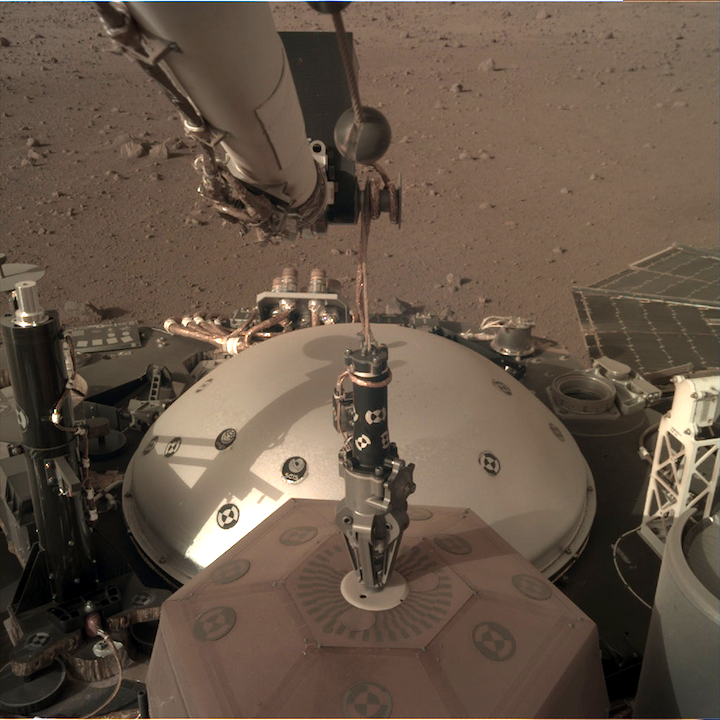
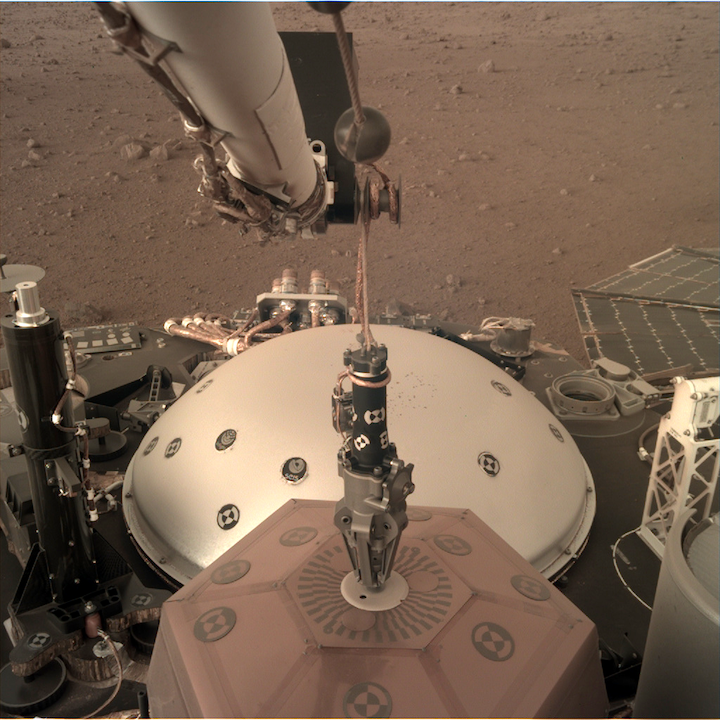
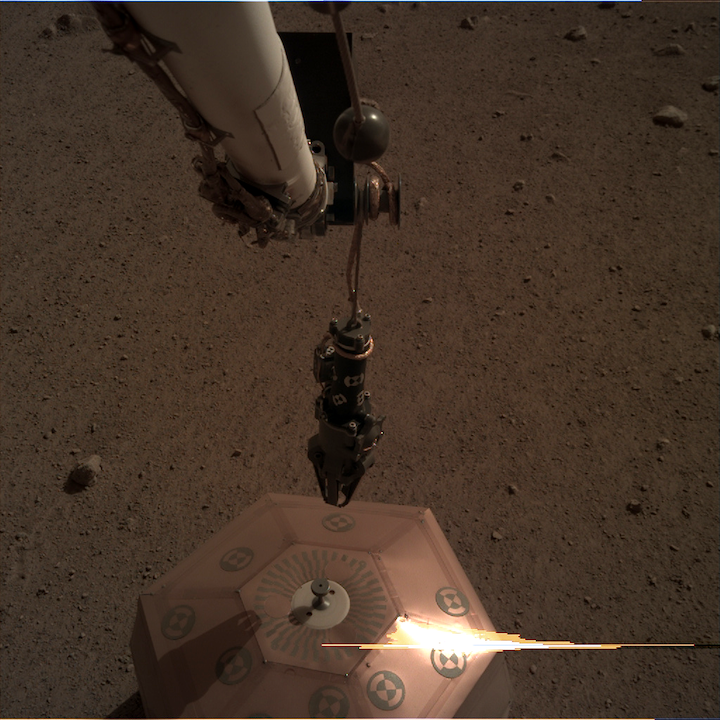
Sol 22: Instrument Deployment Camera (IDC)
NASA's InSight Mars lander acquired this image using its robotic arm-mounted, Instrument Deployment Camera (IDC).
This image was acquired on December 19, 2018, Sol 22 where the local mean solar time for the image exposures was 17:58:03 PM. Each IDC image has a field of view of 45 x 45 degrees.
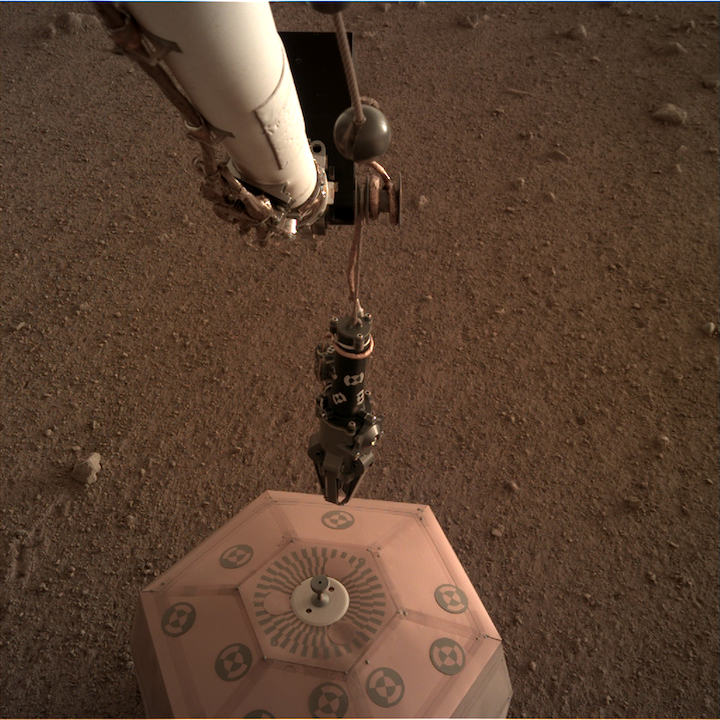
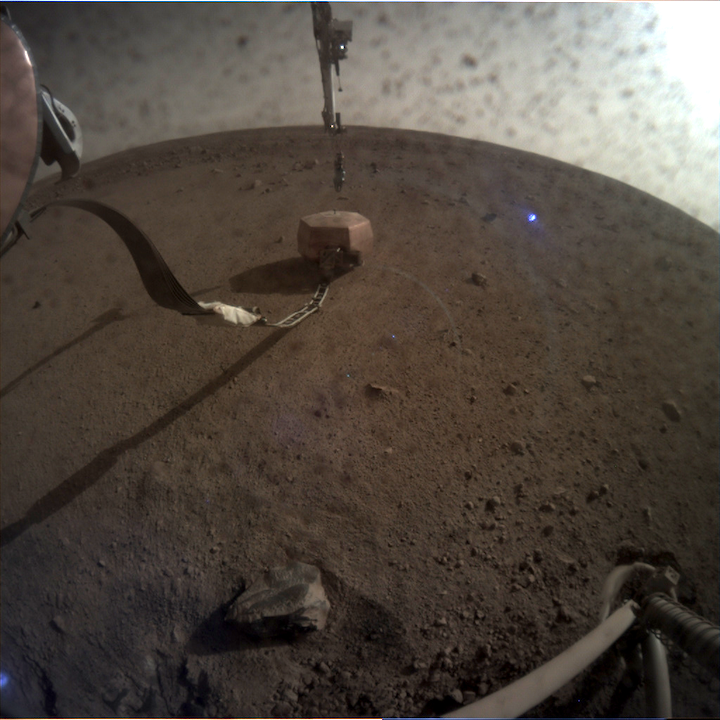
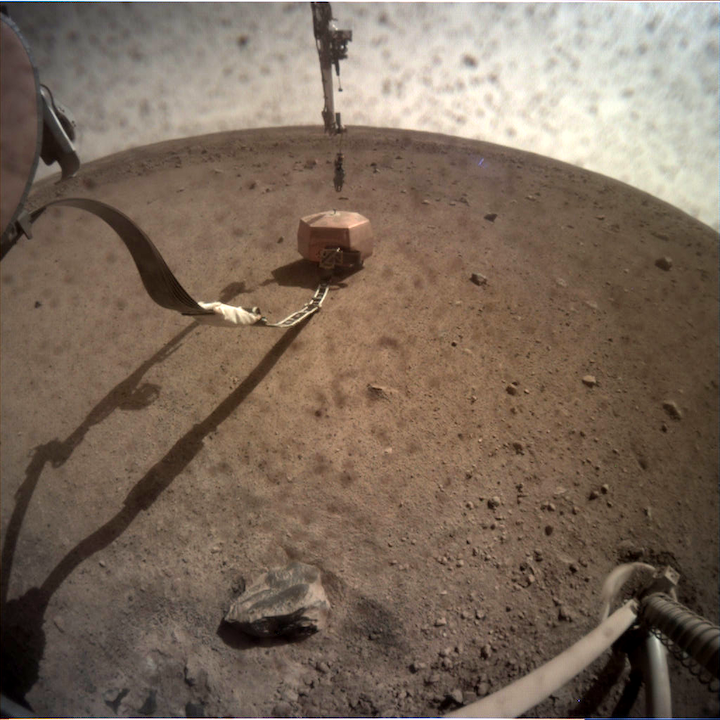
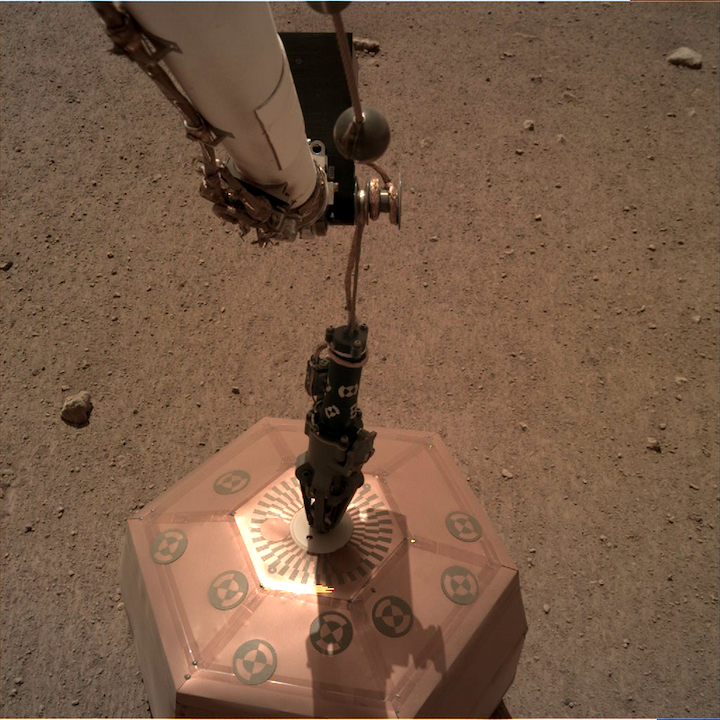
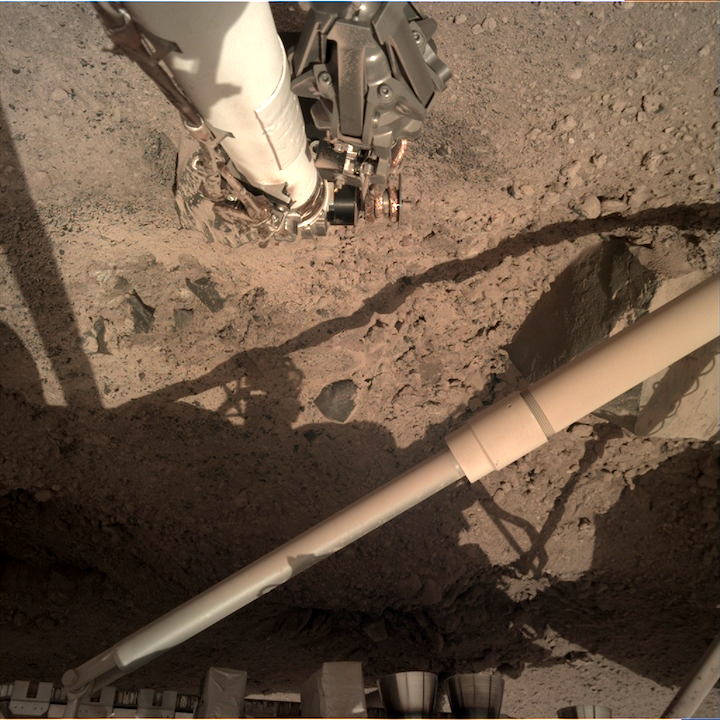
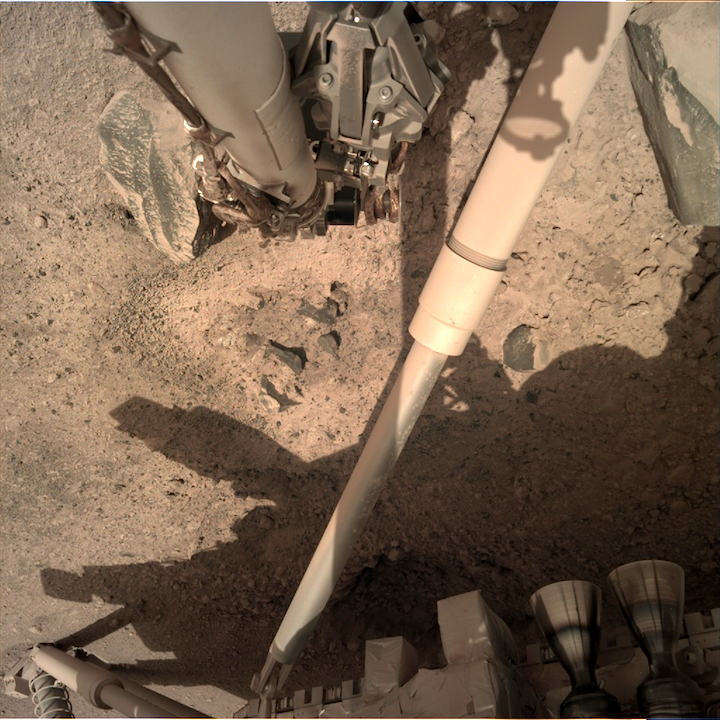
Sol 18: Instrument Deployment Camera (IDC)
NASA's InSight Mars lander acquired this image using its robotic arm-mounted, Instrument Deployment Camera (IDC).
This image was acquired on December 15, 2018, Sol 18 where the local mean solar time for the image exposures was 13:27:20 PM. Each IDC image has a field of view of 45 x 45 degrees.
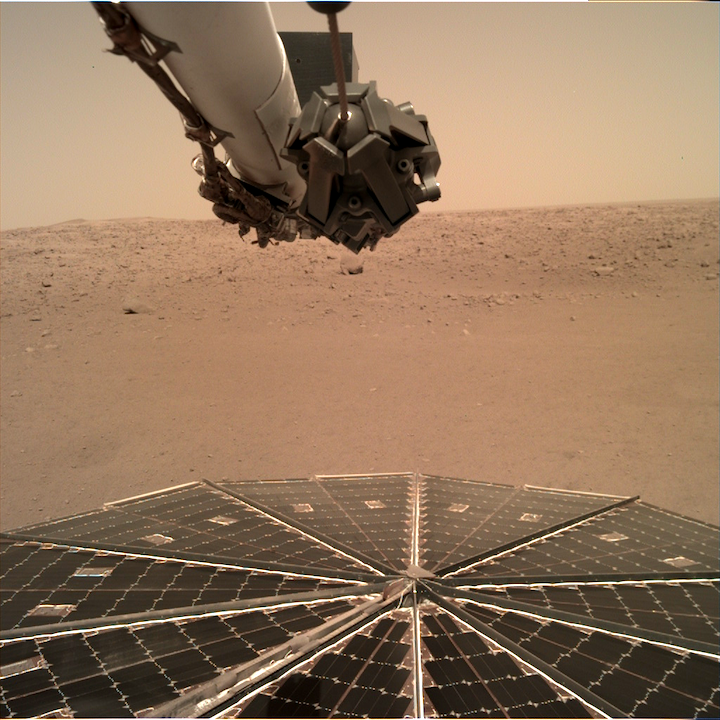
Sol 14: Instrument Deployment Camera (IDC)
NASA's InSight Mars lander acquired this image using its robotic arm-mounted, Instrument Deployment Camera (IDC).
This image was acquired on December 11, 2018, Sol 14 where the local mean solar time for the image exposures was 13:37:23 PM. Each IDC image has a field of view of 45 x 45 degrees.
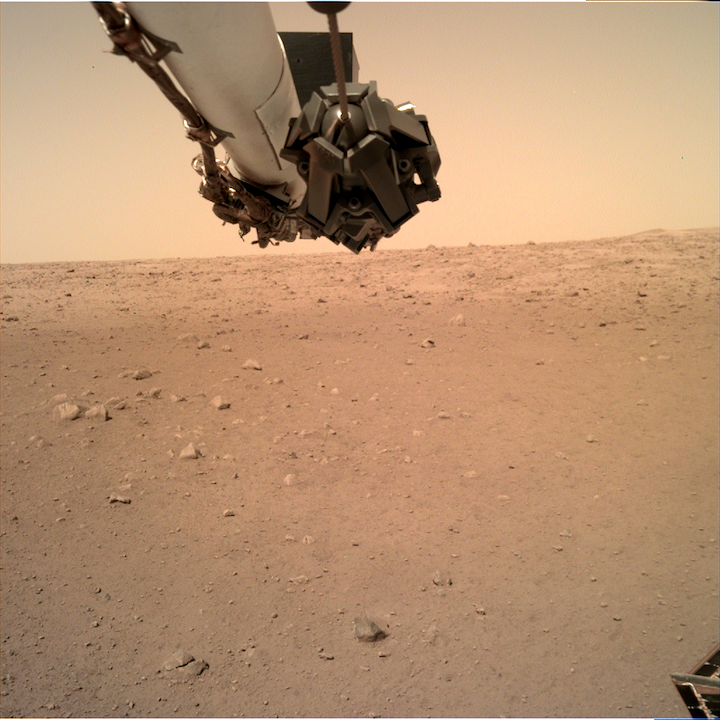
Sol 14: Instrument Deployment Camera (IDC)
NASA's InSight Mars lander acquired this image using its robotic arm-mounted, Instrument Deployment Camera (IDC).
This image was acquired on December 11, 2018, Sol 14 where the local mean solar time for the image exposures was 13:30:04 PM. Each IDC image has a field of view of 45 x 45 degrees.
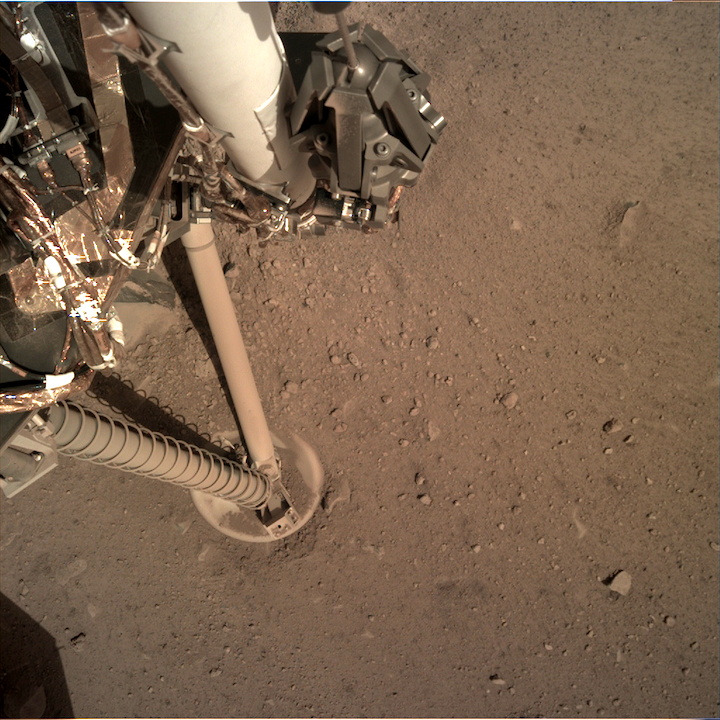
Sol 10: Instrument Deployment Camera (IDC)
NASA's InSight Mars lander acquired this image using its robotic arm-mounted, Instrument Deployment Camera (IDC).
This image was acquired on December 7, 2018, Sol 10 where the local mean solar time for the image exposures was 12:05:12 PM. Each IDC image has a field of view of 45 x 45 degrees.
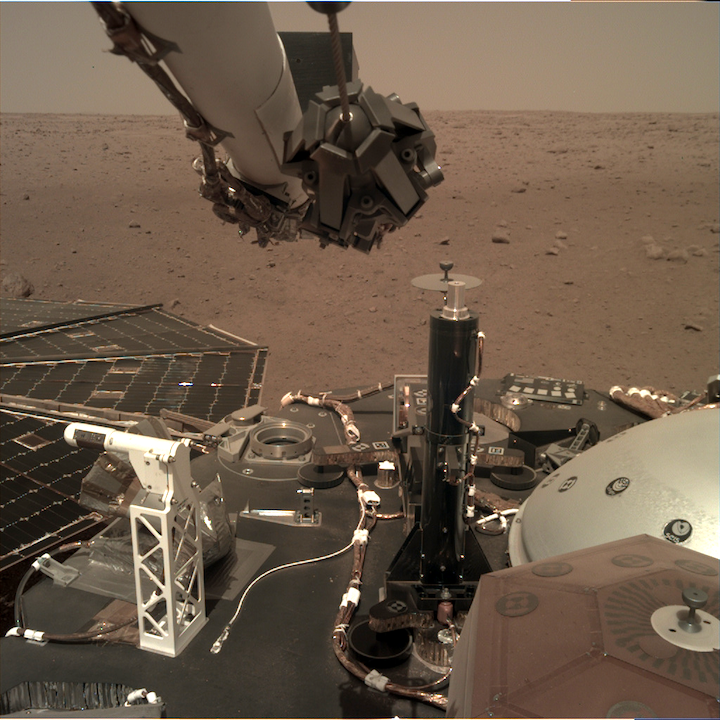
Sol 10: Instrument Deployment Camera (IDC)
NASA's InSight Mars lander acquired this image using its robotic arm-mounted, Instrument Deployment Camera (IDC).
This image was acquired on December 7, 2018, Sol 10 where the local mean solar time for the image exposures was 11:43:13 AM. Each IDC image has a field of view of 45 x 45 degrees.
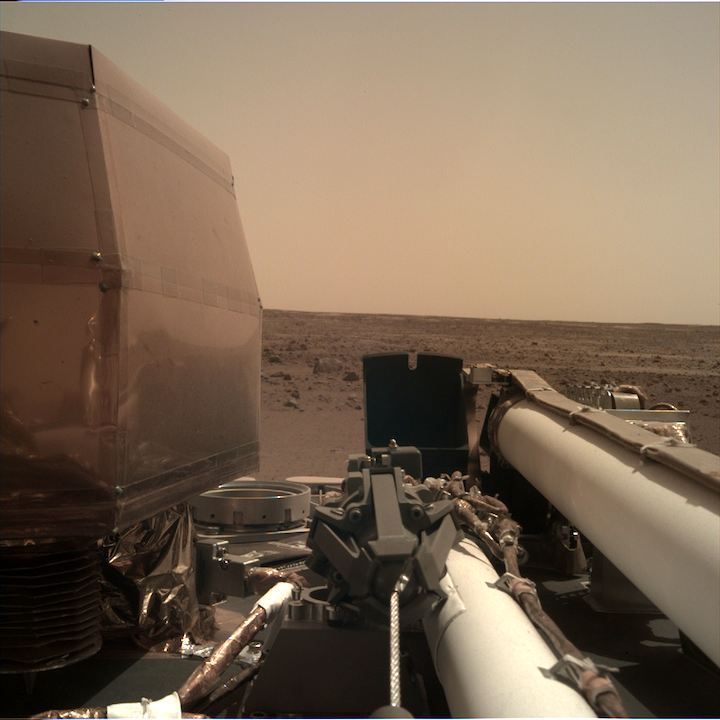
Sol 4: Instrument Deployment Camera (IDC)
NASA's InSight Mars lander acquired this image using its robotic arm-mounted, Instrument Deployment Camera (IDC).
This image was acquired on November 30, 2018, Sol 4 where the local mean solar time for the image exposures was 13:03:41 PM. Each IDC image has a field of view of 45 x 45 degrees.
Quelle: NASA
-----
Update: 29.12.2018
.
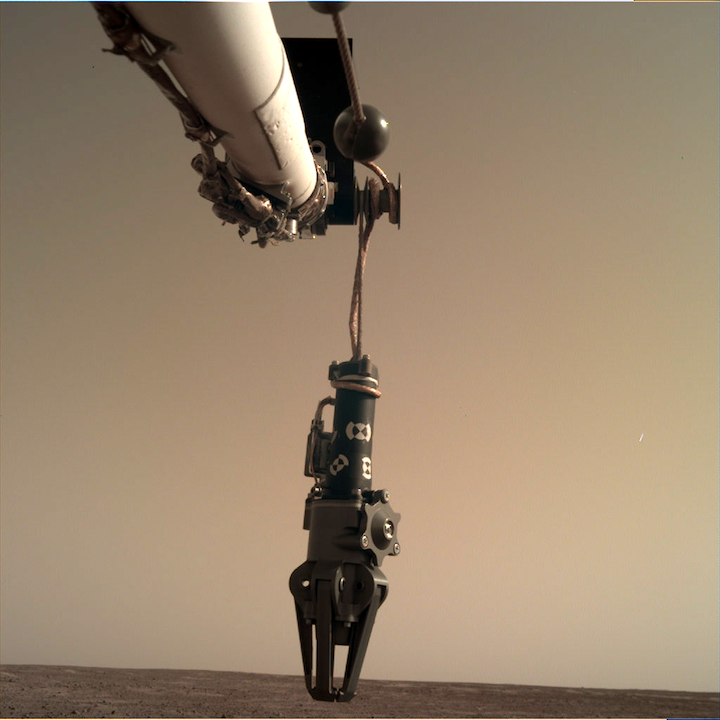
Sol 26: Instrument Deployment Camera (IDC)
NASA's InSight Mars lander acquired this image using its robotic arm-mounted, Instrument Deployment Camera (IDC).
This image was acquired on December 23, 2018, Sol 26 where the local mean solar time for the image exposures was 15:32:07 PM. Each IDC image has a field of view of 45 x 45 degrees.
Quelle: NASA
----
Update: 7.01.2019
.
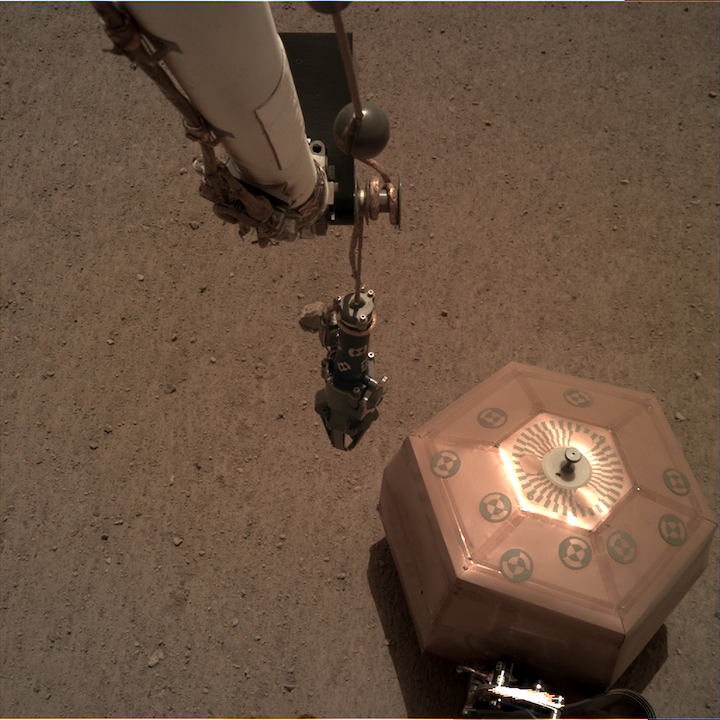
Sol 37: Instrument Deployment Camera (IDC)
NASA's InSight Mars lander acquired this image using its robotic arm-mounted, Instrument Deployment Camera (IDC).
This image was acquired on January 3, 2019, Sol 37 where the local mean solar time for the image exposures was 12:59:22.077 PM. Each IDC image has a field of view of 45 x 45 degrees.
+++
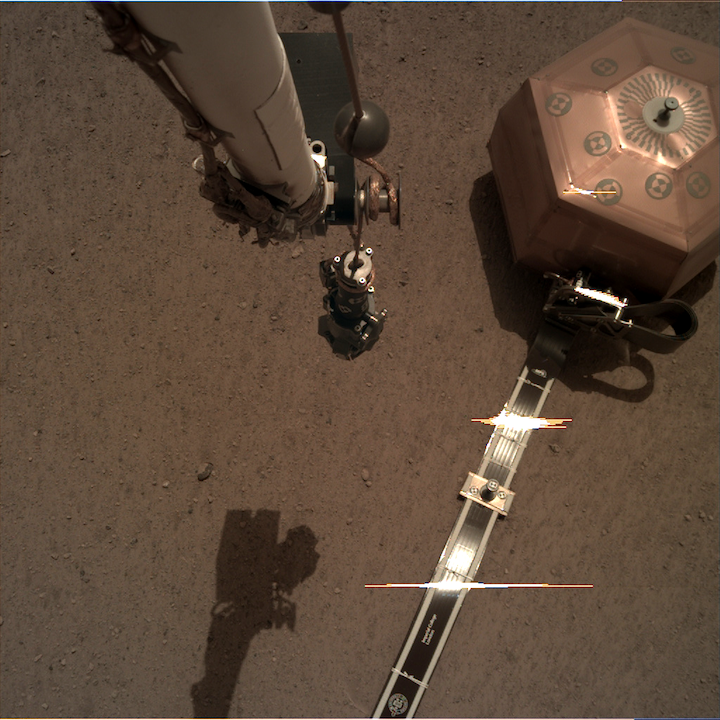
Sol 37: Instrument Deployment Camera (IDC)
NASA's InSight Mars lander acquired this image using its robotic arm-mounted, Instrument Deployment Camera (IDC).
This image was acquired on January 3, 2019, Sol 37 where the local mean solar time for the image exposures was 13:03:49.720 PM. Each IDC image has a field of view of 45 x 45 degrees.
+++
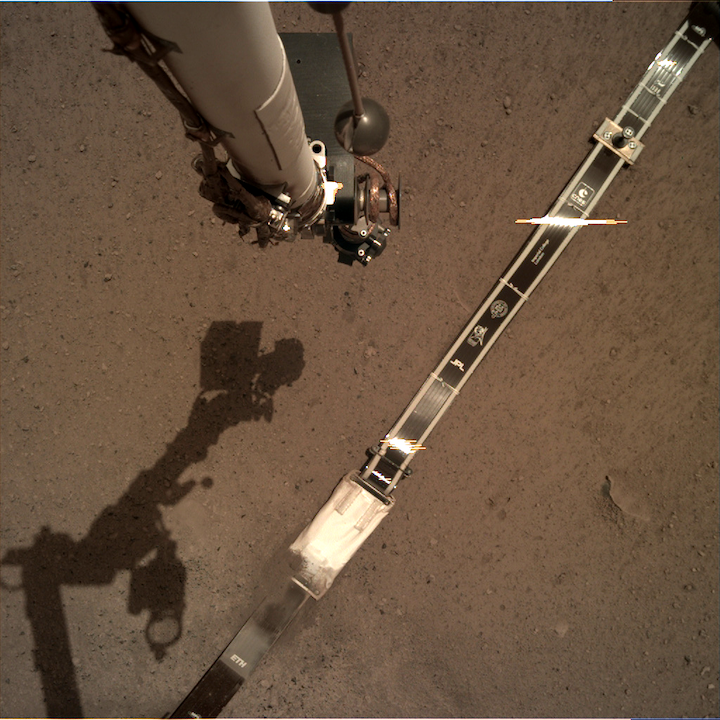
Sol 37: Instrument Deployment Camera (IDC)
NASA's InSight Mars lander acquired this image using its robotic arm-mounted, Instrument Deployment Camera (IDC).
This image was acquired on January 3, 2019, Sol 37 where the local mean solar time for the image exposures was 13:08:00.817 PM. Each IDC image has a field of view of 45 x 45 degrees.
+++
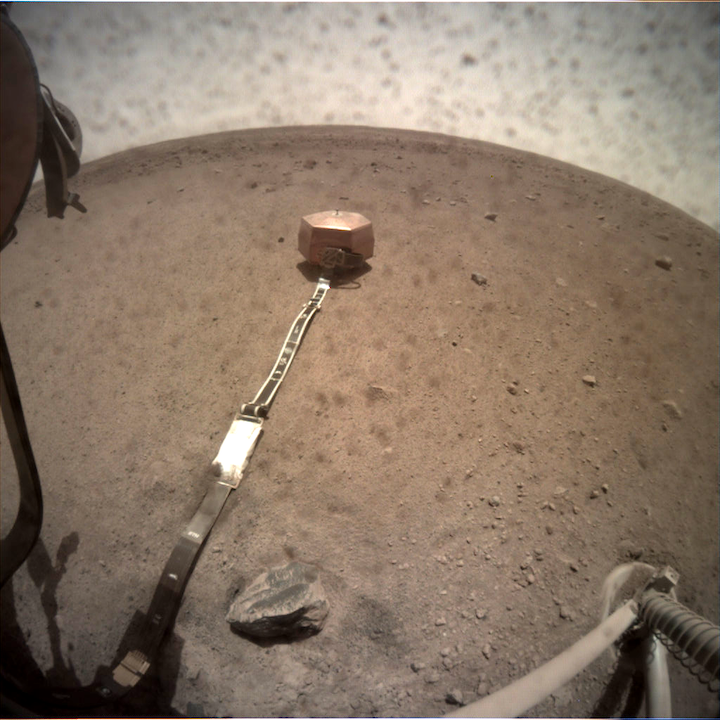
Sol 40: Instrument Context Camera (ICC)
NASA's InSight Mars lander acquired this image of the area in front of the lander using its lander-mounted, Instrument Context Camera (ICC).
This image was acquired on January 6, 2019, Sol 40 of the InSight mission where the local mean solar time for the image exposures was 13:06:26.123 PM. Each ICC image has a field of view of 124 x 124 degrees.
+++
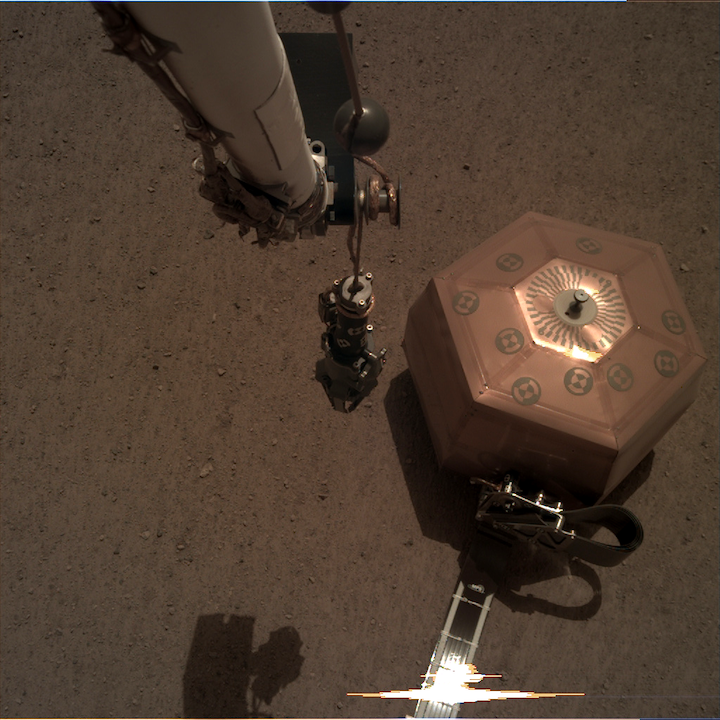
Sol 40: Instrument Deployment Camera (IDC)
NASA's InSight Mars lander acquired this image using its robotic arm-mounted, Instrument Deployment Camera (IDC).
This image was acquired on January 6, 2019, Sol 40 where the local mean solar time for the image exposures was 13:15:34.060 PM. Each IDC image has a field of view of 45 x 45 degrees.
Quelle: NASA
+++
NASA's InSight Places First Instrument on Mars
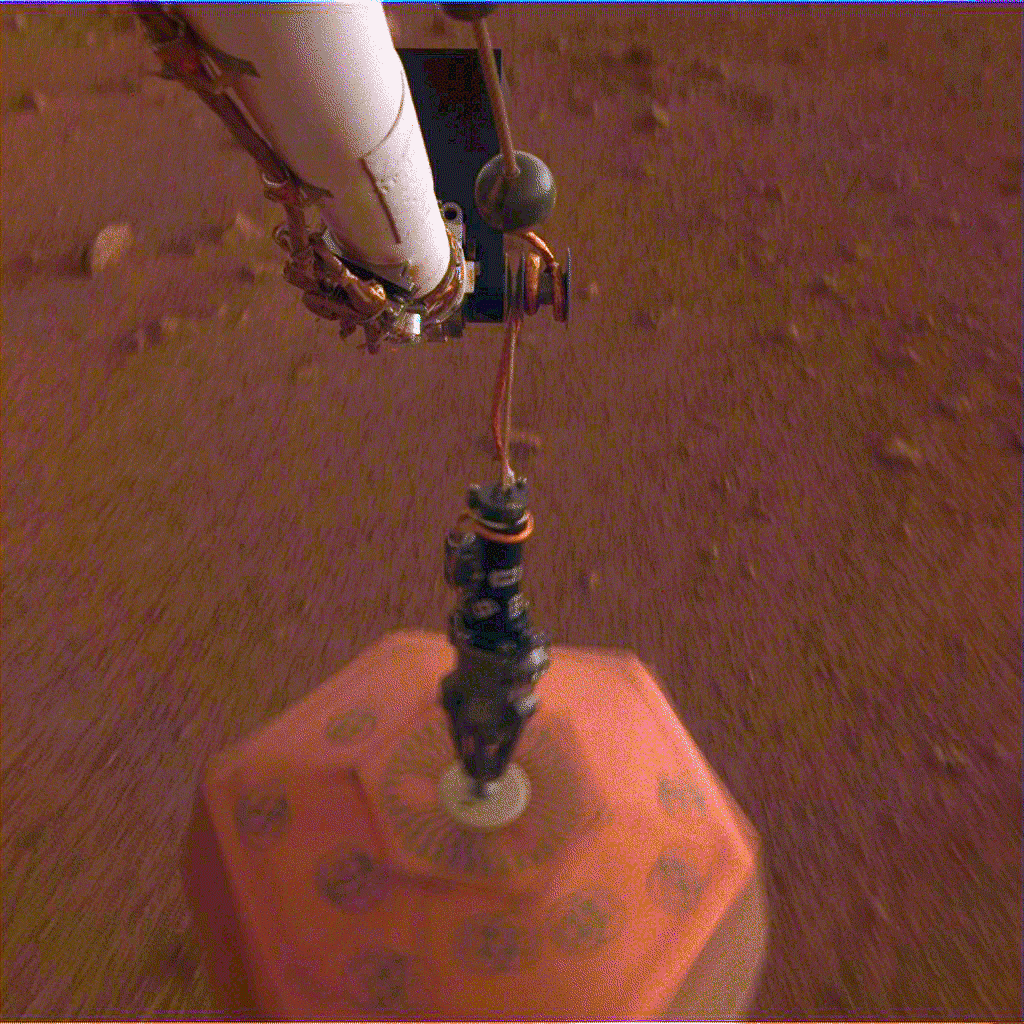
This set of images from the Instrument Deployment Camera shows NASA's InSight lander placing its first instrument onto the surface of Mars, completing a major mission milestone. Image Credit: NASA/JPL-Caltech.
NASA's InSight lander has deployed its first instrument onto the surface of Mars, completing a major mission milestone. New images from the lander show the seismometer on the ground, its copper-colored covering faintly illuminated in the Martian dusk. It looks as if all is calm and all is bright for InSight, heading into the end of the year.
The InSight team has been working carefully toward deploying its two dedicated science instruments onto Martian soil since landing on Mars on Nov. 26. Meanwhile, the Rotation and Interior Structure Experiment (RISE), which does not have its own separate instrument, has already begun using InSight's radio connection with Earth to collect preliminary data on the planet’s core. Not enough time has elapsed for scientists to deduce what they want to know — scientists estimate they might have some results starting in about a year.
To deploy the seismometer (also known as the Seismic Experiment for Interior Structure, or SEIS) and the heat probe (also known as the Heat Flow and Physical Properties Probe, or HP3), engineers first had to verify the robotic arm that picks up and places InSight's instruments onto the Martian surface was working properly. Engineers tested the commands for the lander, making sure a model in the test bed at JPL deployed the instruments exactly as intended. Scientists also had to analyze images of the Martian terrain around the lander to figure out the best places to deploy the instruments.
On Tuesday, Dec. 18, InSight engineers sent up the commands to the spacecraft. On Wednesday, Dec. 19, the seismometer was gently placed onto the ground directly in front of the lander, about as far away as the arm can reach ---- 5.367 feet, or 1.636 meters, away).
"Seismometer deployment is as important as landing InSight on Mars," said InSight Principal Investigator Bruce Banerdt, also based at JPL. "The seismometer is the highest-priority instrument on InSight: We need it in order to complete about three-quarters of our science objectives."
The seismometer allows scientists to peer into the Martian interior by studying ground motion — also known as marsquakes. Each marsquake acts as a kind of flashbulb that illuminates the structure of the planet's interior. By analyzing how seismic waves pass through the layers of the planet, scientists can deduce the depth and composition of these layers.
"Having the seismometer on the ground is like holding a phone up to your ear," said Philippe Lognonné, principal investigator of SEIS from Institut de Physique du Globe de Paris (IPGP) and Paris Diderot University. "We're thrilled that we're now in the best position to listen to all the seismic waves from below Mars' surface and from its deep interior."
In the coming days, the InSight team will work on leveling the seismometer, which is sitting on ground that is tilted 2 to 3 degrees. The first seismometer science data should begin to flow back to Earth after the seismometer is in the right position.
But engineers and scientists at JPL, the French national space agency Centre National d'Études Spatiales (CNES) and other institutions affiliated with the SEIS team will need several additional weeks to make sure the returned data are as clear as possible. For one thing, they will check and possibly adjust the seismometer's long, wire-lined tether to minimize noise that could travel along it to the seismometer. Then, in early January, engineers expect to command the robotic arm to place the Wind and Thermal Shield over the seismometer to stabilize the environment around the sensors.
Assuming that there are no unexpected issues, the InSight team plans to deploy the heat probe onto the Martian surface by late January. HP3 will be on the east side of the lander's work space, roughly the same distance away from the lander as the seismometer.
For now, though, the team is focusing on getting those first bits of seismic data (however noisy) back from the Martian surface.
"We look forward to popping some Champagne when we start to get data from InSight's seismometer on the ground," Banerdt added. "I have a bottle ready for the occasion."
JPL manages InSight for NASA's Science Mission Directorate in Washington. InSight is part of NASA's Discovery Program, which is managed by NASA's Marshall Space Flight Center in Huntsville, Alabama. Lockheed Martin Space in Denver built the InSight spacecraft, including its cruise stage and lander, and supports spacecraft operations for the mission.
A number of European partners, including CNES and the German Aerospace Center (DLR), support the InSight mission. CNES provided SEIS to NASA, with the principal investigator at IPGP. Significant contributions for SEIS came from IPGP, the Max Planck Institute for Solar System Research in Germany, the Swiss Institute of Technology in Switzerland, Imperial College and Oxford University in the United Kingdom, and JPL. DLR provided the Heat Flow and Physical Properties Package (HP3) instrument, with significant contributions from the Space Research Center of the Polish Academy of Sciences and Astronika in Poland. Spain's Centro de Astrobiología supplied the wind sensors.
Quelle: NASA
----
Update: 23.01.2019
.
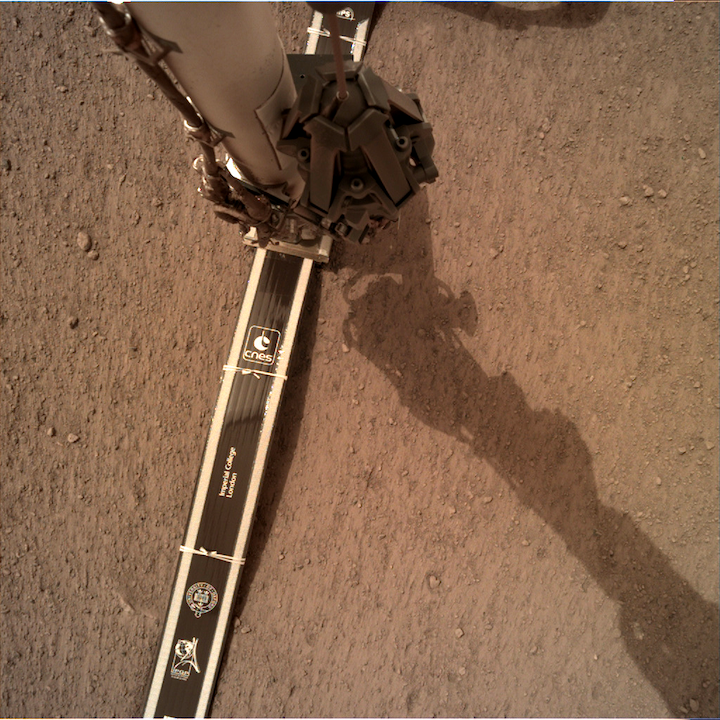
Sol 52: Instrument Deployment Camera (IDC)
NASA's InSight Mars lander acquired this image using its robotic arm-mounted, Instrument Deployment Camera (IDC).
This image was acquired on January 19, 2019, Sol 52 where the local mean solar time for the image exposures was 11:17:23.779 AM. Each IDC image has a field of view of 45 x 45 degrees.
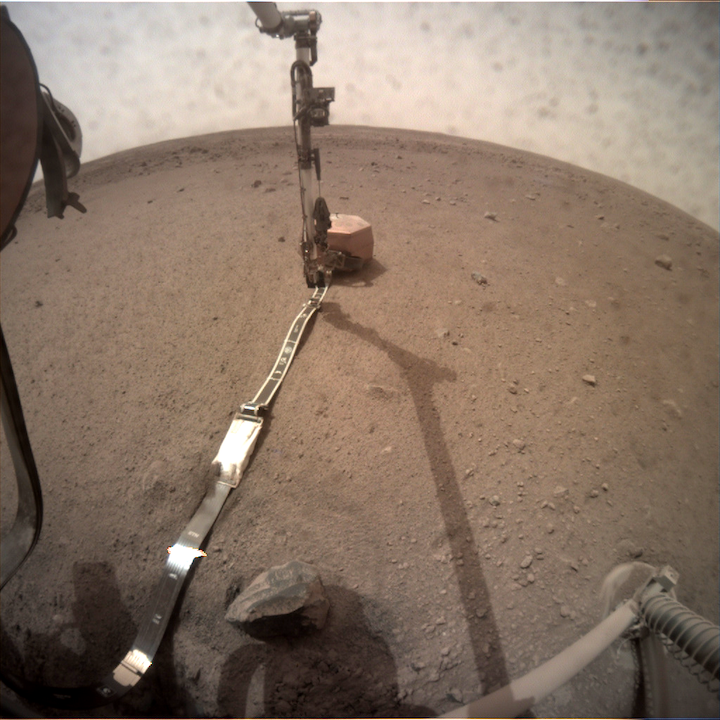
Sol 52: Instrument Context Camera (ICC)
NASA's InSight Mars lander acquired this image of the area in front of the lander using its lander-mounted, Instrument Context Camera (ICC).
This image was acquired on January 19, 2019, Sol 52 of the InSight mission where the local mean solar time for the image exposures was 11:19:04.996 AM. Each ICC image has a field of view of 124 x 124 degrees.
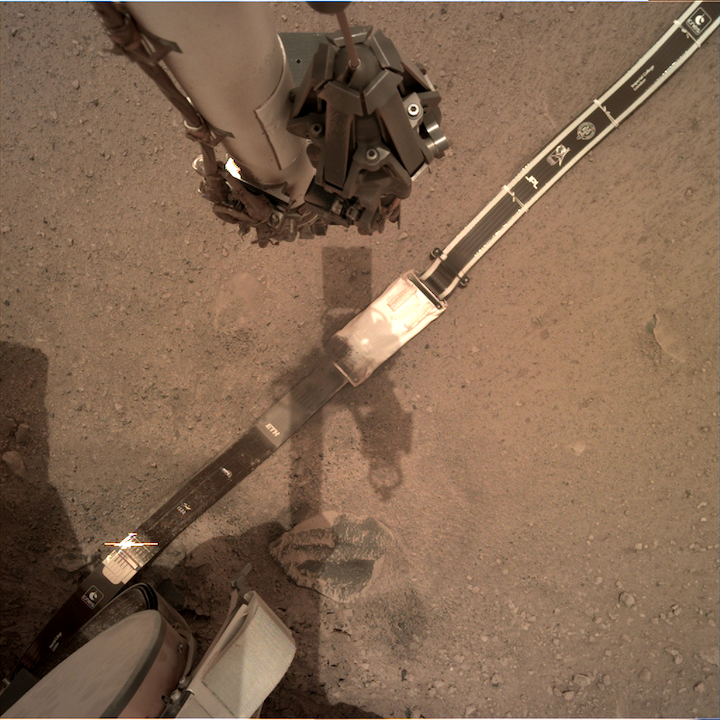
Sol 53: Instrument Deployment Camera (IDC)
NASA's InSight Mars lander acquired this image using its robotic arm-mounted, Instrument Deployment Camera (IDC).
This image was acquired on January 20, 2019, Sol 53 where the local mean solar time for the image exposures was 12:01:40.644 PM. Each IDC image has a field of view of 45 x 45 degrees.
Quelle: NASA
----
Update: 4.02.2019
.
NASA gives Cypriot dialect names to rocks on Mars surface
They were given their names by Dr Konstantinos Charalambous, who is part of the InSight mission
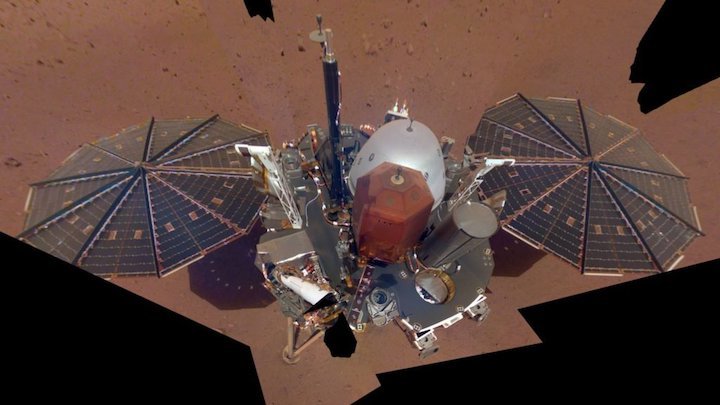
Two small pieces of rock on the surface of Mars were named after words of the Cypriot dialect, ‘zavos (i.e. ’tiltedl/ not straight’) and ‘mutti’ (i.e. peak, highest point).
The two rocks are adjacent to the stationary InSight lander and are to be documented, analyzed and featured in articles and conferences. They were given their names by Dr Konstantinos Charalambous, one of the scientists who take part in NASA’s InSight mission. The 33-year-old Cypriot scientist, who holds a PhD in Planetary Sciences from London’s Imperieal College, suggested the names, in a least featuring other Cypriot word and their meanings.
“So, somewhere there on the planet Mars there is a small piece of our Cyprus,” Dr Charalambous said, talking to the Cyprus News Agency.
